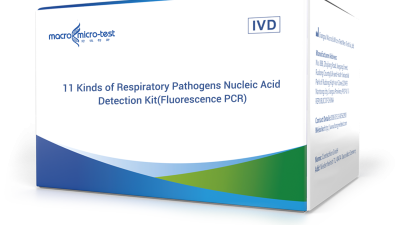The Future of Best tt3 Innovations in Efficiency and Performance
Table of Contents
- Emerging Technologies Driving TT3 Innovations in Efficiency
- Integrating AI and Machine Learning for Enhanced Performance
- Exploring Sustainable Practices in TT3 Innovations
- Case Studies: Successful TT3 Implementation in Various Industries
- Future Trends: What’s Next for TT3 Efficiency and Performance
- Measuring Success: Key Metrics for Evaluating TT3 Innovations
- Exploring the Benefits of Freeze-Dried Nucleic Acid Testing for 11 Respiratory Pathogens
- FAQS
- Related Posts
In the rapidly changing world of medical tech, chasing better efficiency and performance is a total priority. When we look ahead to the future of TT3 innovations, it’s clear that progress isn't just about small tweaks — it’s about game-changing solutions that really boost diagnostic abilities. Take Jiangsu Macro & Micro-Test Med-Tech Co., Ltd., for example. Founded back in 2010 in Beijing, they've really made a name for themselves by focusing on R&D, manufacturing, and selling cutting-edge detection tools and new in vitro diagnostic reagents. They’re leveraging their own innovative tech and top-notch manufacturing skills to stay at the forefront of this field. This guide is gonna dive into what’s exciting about TT3 innovations and how they might completely transform efficiency and performance in diagnostics around the world.

Emerging Technologies Driving TT3 Innovations in Efficiency
You know, in the TT3 world, everyone’s really pushed to get better and faster, and new tech is shaping that whole scene big time. Things like artificial intelligence and smarter machine learning algorithms are really changing how decisions are made—sometimes on the fly—which means companies can keep things running smoothly without missing a beat. More and more, businesses are using predictive analytics to spot potential issues early on and fix them before they turn into major problems, cutting down on downtime and really cranking up productivity. When you add AI insights into the mix, processes become more streamlined, and you can tell the difference in overall performance—it’s pretty remarkable.
And then there’s the rise of IoT devices—that’s the Internet of Things—which is totally changing how data is gathered in TT3 setups. These gadgets are interconnected and keep tabs on all kinds of important metrics, giving companies a level of insight that just wasn’t possible before. Having real-time data means they can tweak and adapt their operations instantly, making things more efficient and responsive. It’s not just about working better; it also sparks innovation, since organizations can respond faster to problems and better manage their resources. All these tech advances together are setting the stage for a real game-changer in TT3—where smarter, data-driven strategies lead the way to higher efficiency and performance.
Integrating AI and Machine Learning for Enhanced Performance
You know, the way artificial intelligence (AI) and machine learning (ML) are shaking things up is pretty incredible, especially in fields like banking and cloud computing. I’ve been reading about how newer AI-driven tools are really boosting how efficiently businesses run, and it’s leading to some pretty solid improvements in their performance metrics. For example, the banking sector has seen a real jump in results after they started using AI — it’s like a game-changer for financial tech and how money flows around the economy.
And it doesn’t stop there. AI is also transforming how companies manage their cloud resources. With smart ML algorithms, organizations can automate a lot more and become way more efficient behind the scenes. This doesn’t just cut down costs — it makes everything smoother and faster, so teams can spend more time on new ideas and making their customers happy. As more industries jump on the AI train, the combined power of AI and ML promises even more exciting developments ahead, especially in areas like energy efficiency, healthcare diagnostics, and even education — like personalized learning that adapts to each student’s needs.

Exploring Sustainable Practices in TT3 Innovations
These days, with medical tech evolving so quickly, sustainability is really starting to become a key part of innovation—especially when it comes to TT3 innovations. Jiangsu Macro & Micro-Test Med-Tech Co., Ltd. is actually leading the charge here, pushing forward in R&D for in vitro diagnostic reagents that focus not just on being efficient and high-performing, but also on being eco-friendly. A recent industry report mentioned that demand for sustainable medical diagnostics is expected to grow around 15% each year—pretty significant, right? It's clear we're shifting toward greener, more responsible tech.
For companies serious about going green, embracing innovative manufacturing methods is crucial. Our dedication to quality and our own tech solutions helps us cut down on waste and manage our products better throughout their entire lifecycle. By switching to renewable materials and energy-saving tech, organizations can really shrink their carbon footprint.
Pro tip: Investing in R&D for sustainable materials can really boost your product appeal—and it helps you stay ahead of the game as regulations get stricter around environmentally friendly solutions. Also, it’s a smart move to work closely with suppliers who prioritize sustainability. These kinds of collaborations don’t just improve outcomes—they set new standards for eco-friendly TT3 innovations across the industry.
The Future of Best TT3 Innovations in Efficiency and Performance
This chart illustrates the efficiency improvements and performance enhancements brought about by various TT3 innovations over the years, emphasizing sustainable practices.
Case Studies: Successful TT3 Implementation in Various Industries
You know, the integration of TT3 innovations across different industries has really sparked some impressive improvements in efficiency and performance—especially in healthcare. Companies like Jiangsu Macro & Micro-Test Med-Tech Co., Ltd. are leading the charge here, using cutting-edge detection tech and new in vitro diagnostic reagents to shake things up. A recent industry report even predicted that the global market for in vitro diagnostics could hit $85 billion by 2025—that's a clear sign how much there's a growing demand for innovative solutions that help improve patient outcomes and streamline operations.
If you look at some real-world examples, you'll see how successful TT3 implementation can make a difference. Take a well-known diagnostic lab, for instance—after adopting TT3 tech, they managed to cut test result turnaround times by about 30%. That means doctors get the info they need faster, which can be a game-changer in patient care. Plus, these innovations have helped them stick to strict quality standards, leading to a big drop in errors—now down to less than 1%. All in all, this really shows how TT3 isn't just boosting operational performance, but also making the quality of care patients receive much better.
Future Trends: What’s Next for TT3 Efficiency and Performance
Lately, there's been quite a buzz around efficiency and performance in the TT3 sector. You know, it’s pretty cool — according to a recent report by McKinsey & Company, companies that have started using more advanced tech in their systems are seeing a solid boost, like 20 to 30% better in operational efficiency. Looking ahead, it’s pretty obvious that AI and machine learning are going to be game-changers for TT3 innovations. These tools not only make processes smoother but also give real-time data, which helps in making smarter decisions, sometimes even on the fly.
If you wanna stay ahead of the game, I’d say businesses should really think about investing in training for their teams. When employees get up-to-speed on the latest tech, it sparks innovation and helps everything run more smoothly.
And here’s the thing — sustainability is quickly becoming a big deal in this whole efficiency thing. The International Energy Agency predicts that by 2025, over 40% of new tech will focus on energy savings and cutting down carbon footprints. It’s like the industry is shifting towards greener, more eco-friendly practices, and that can seriously boost performance metrics too.
So for companies ready to keep up, adopting a mindset of continuous improvement makes a lot of sense. That means regularly checking and updating their tech to match the latest sustainability standards — staying flexible and sharp as things evolve.
Measuring Success: Key Metrics for Evaluating TT3 Innovations
Figuring out whether TT3 innovations are really paying off in terms of efficiency and performance isn’t straightforward—it all boils down to a few key metrics that reflect their real impact on the industry. I read in a report by McKinsey that companies who jump into advanced TT3 systems often see a boost of about 20-30% in how efficiently they run things. That’s pretty significant, and it highlights how important it is to keep an eye on things like overall equipment effectiveness (OEE) and mean time to repair (MTTR). These help businesses figure out where TT3 innovations can make the biggest difference.
On top of that, Gartner’s survey shows that about 72% of organizations see customer satisfaction as a top success metric when rolling out new TT3 tech. The cool part? These innovations can really help streamline processes that directly make customers happier—think quicker service, better experiences—which in turn helps with loyalty and retention. Metrics like Net Promoter Score (NPS) and customer effort score (CES) are especially useful here. By consistently tracking these indicators, companies can make sure their efforts not only improve efficiency but also truly resonate with their customers, leading to better overall performance.

Exploring the Benefits of Freeze-Dried Nucleic Acid Testing for 11 Respiratory Pathogens
The increasing prevalence of respiratory infections calls for advanced diagnostic solutions that can offer quick and reliable results. Freeze-dried nucleic acid testing presents an innovative approach to detecting a variety of respiratory pathogens, with significant benefits for patient care. This technology minimizes the need for refrigeration, ensuring a more robust shelf life and convenient storage while maintaining the accuracy of the testing process.
One such testing kit is designed for the qualitative detection of multiple common respiratory pathogens, including Haemophilus influenzae, Streptococcus pneumoniae, and Pseudomonas aeruginosa, among others. This comprehensive panel allows healthcare professionals to identify specific bacterial infections rapidly, particularly in hospitalized or critically ill patients. Prompt and accurate diagnosis is crucial for administering timely treatments, improving outcomes, and potentially saving lives.
The ease of use and effectiveness of freeze-dried nucleic acid testing make it an invaluable tool in today’s healthcare landscape. By providing essential insights into the respiratory pathogens affecting patients, this testing method enhances clinical decision-making and paves the way for targeted therapeutic interventions, thereby playing a crucial role in combating respiratory illnesses.
FAQS
: TT3 innovations primarily focus on integrating sustainability into medical technology by developing eco-friendly in vitro diagnostic reagents and manufacturing processes.
The demand for sustainable medical diagnostics is projected to grow by 15% annually, indicating a significant shift towards environmentally responsible technologies.
Companies can pursue sustainable practices by leveraging innovative manufacturing processes, minimizing waste, adopting renewable materials, and employing energy-efficient technologies.
Investing in R&D focused on sustainable materials can enhance product appeal and help companies meet growing regulatory demands for greener solutions.
The global market for in vitro diagnostics is projected to reach $85 billion by 2025.
TT3 technology has resulted in a 30% reduction in turnaround times for test results in diagnostic laboratories, enabling quicker decision-making for healthcare providers.
The implementation of TT3 innovations has led to a notable decrease in error rates in diagnostics, which now stands at less than 1%.
Engaging with suppliers who prioritize sustainability is important as it can create a more comprehensive eco-friendly supply chain, leading to improved outcomes and setting new industry benchmarks.
Adherence to stringent quality standards facilitated by TT3 innovations enhances operational performance and reduces error rates in laboratory settings.
TT3 innovations have been successfully implemented in various industries, particularly in healthcare, where they have significantly advanced efficiency and performance.




